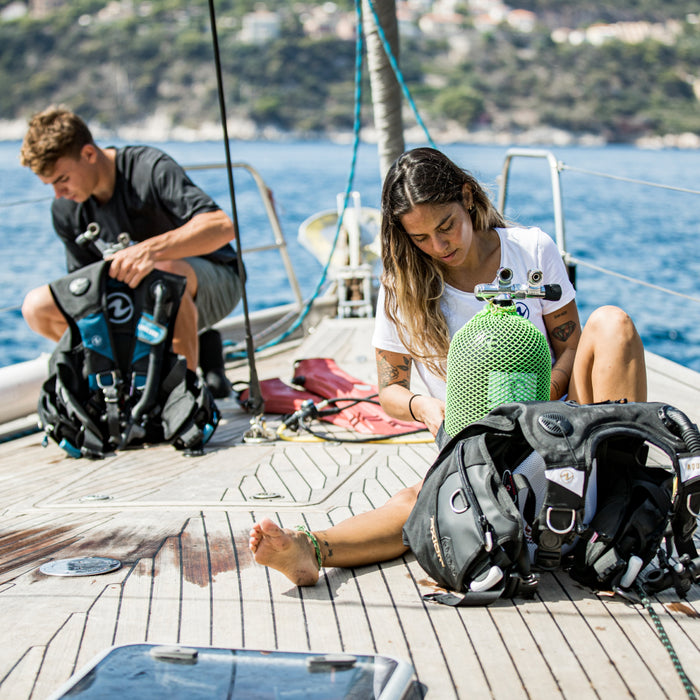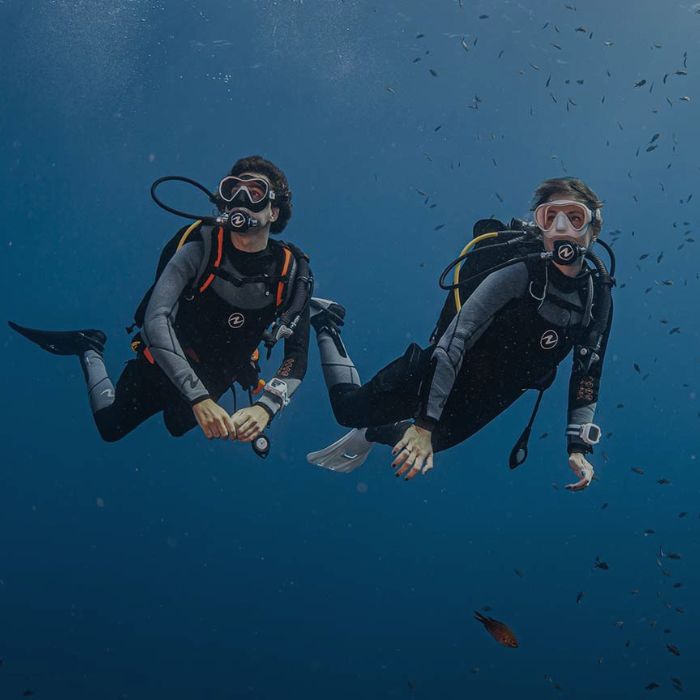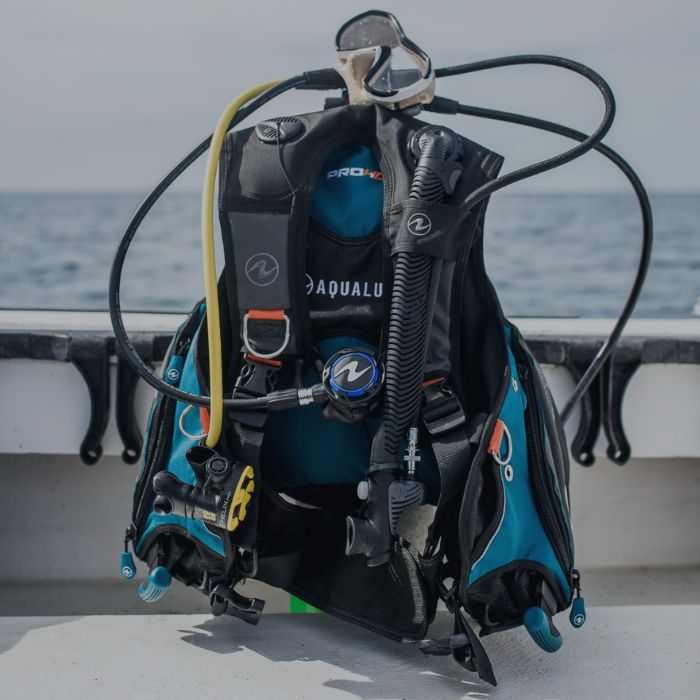
Blog
Table of contents

How to choose your dive bcd ?
The ultimate guide for scuba divers
A well chosen BCD will make diving easier, safer, and more fun! Whether you’re a beginner, a professional diver, or somewhere in between, this guide will help you pick the best BCD for your diving style, environment, and gear preferences.
What is a dive BCD and why do you need one?
Your Buoyancy Control Device (BCD) is your underwater backpack, safety device, and comfort zone all in one. It allows you to control your buoyancy, ascend and descend safely, and carry essential scuba equipment like your tank, weights, and accessories.
Want to find the best Aqualung BCD for you?
Which type of BCD do you need?
There’s no one-size-fits-all when it comes to diving gear. BCD comes in different stylesdesigned to suit various diver profiles and diving conditions.
Jacket style BCD
The classic, all-around option, and most probably the diving BCD you learned to dive with.

Pros:
- Wraps around your body for a secure fit. The bladder surrounds your torso, inflating on the back and the sides.
- Provides a more stable surface position. Balanced inflation can help to keep you upright on the surface.
- High lift capacities. Often offers higher lift useful for carrying extra gear, though this varies by model. Always check the specs based on your needs.
- Integrated weight pockets to hold detachable weights within the BCD, which is more convenient than a traditional weight belt.
- Multiple large pockets located at the front, so it's easy to carry and retrieve dive equipment, such as dive knives, torches, ocean clean up bags etc…
- Familiar to many divers who learned to dive with this style.
Cons:
- Bulkier & heavier since it’s a wrap around.
- Can make achieving horizontal trim underwater more challenging. Usually, the air in your dive BCD will go towards the top pulling you upward a bit.
Best for:
Beginner and recreational divers, instructors, professionals, cold water divers and those who need extra lift capacity and storage.
Back-inflate BCD
The sleek and minimalist choice for divers who prioritize freedom of movement and horizontal trim.

Pros:
- Lightweight, using less materials and thin bladder.
- Easy to pack. It can pack flat or disassembled and is more compact than a jacket style.
- Offers a more streamlined profile underwater. Since it only inflates on the back, it’s much easier for divers to hold a horizontal diving position.
- Greater feeling of freedom. No inflation squeeze around the sides or chest area.
- Integrated weight pockets, much more comfortable than a weight belt to carry weights.
Cons:
- Less storage capacity, as there is usually less or smaller pockets.
- Less lift capacity. Back-inflation BCDs typically offer less lift capacity than jacket BCDs, but not always. Some high-end back-inflate BCDs offer lift equal to or greater than jackets, such as the Aqualung Dimension.
Best for:
Advanced divers, travelers and those who prefer a streamlined profile.
Key factors to consider when choosing a scuba diving BCD
Understanding BCD lift capacity
The lift capacityis the amount of weight a BCD can support when fully inflated.The “right” amount of lift depends on a diver’s size and weight, dive conditions and equipment load.
As a general rule:
- Warm water diving: you’ll wear a thin wetsuit or just a rash guard, meaning less buoyancy and weight, thus a smaller lift capacity is needed.
- Cold water diving: you’ll have a ticker wetsuit or drysuit adding buoyancy and you’ll carry more weight. Thus, you’ll need a BCD that’s going to hold that weight, so with more lift capacity.
A BCD with too much lift may cause unnecessary drag, reducing efficiency underwater.
Choosing the lift capacity will also depend on the type of diver you are. If you’re an instructor carrying multiple accessories, you’ll need a BCD having sufficient lift to support you and your gear.
Choose your dive BCD based on your diver profile
Your diver profile will have an impact on the choice of your BCD.
- Recreational divers: if you dive occasionally, you’ll want to prioritize comfort and ease of use. A jacket-style BCD is a great choice. It’s likely the dive BCD you learned to dive with, offering familiarity and stability. Lift capacity isn’t typically a concern here, since recreational divers usually carry minimal gear.
- Advanced divers: you’re likely traveling often in search of the best dive destinations. Look for a streamlined, travel friendly BCD that offers excellent buoyancy control. A modular and back-inflate BCD is ideal for lighter and compact packing, and improved horizontal trim underwater.
- Professional divers & Instructors: if you’re diving daily, teaching, or guiding others, durability and performance are key. You’ll need a high-lift capacity jacket-style BCD built to handle intensive use. Look for extra storage, reinforced materials, and the ability to carry additional weight and accessories like slates, octopus, and teaching tools.

Which inflation system should you choose?
If you are a frequent traveler,choosing a travelfriendly BCD will make your diving trips much easier. Here are somefeatures to look for:
- Lightweight construction: travel BCDs are specifically designed to reduce bulk while keeping essential features. Lightweight materials for accessories, like D-rings, can also help shed extra grams.
- Back-inflate style: usually less bulky and more streamlined than jacket style.
- Compact packing: some BCDs are designed to pack flat or can be disassembled, which will save space in your dive bag.
- Durable materials: choose materials that offer great resistance to abrasion and that can withstand the wear and tear of travel.
Pro tip : the Aqualung Rogue BCD offers modularity, lightweight construction and performance, perfect for traveling!
How to get the right BCD size?
Getting the proper BCD size is key to comfort, control, and saving energy underwater.Your dive BCD should feel snug but not tight.
Here’s a quick fit checklist:
- Shoulder straps allow full arm movement.
- Waist strap sits comfortably without pinching.
- No excess ride-up when inflated at the surface.
- If possible, try it with your wetsuit or drysuit on.
- Fully inflate it orally to make sure it’s still comfortable.
Pro tip : jacket style BCD requires the most precise sizing. If it’s too loose, you’ll tend to slide in it, plus it will add more drag. This can lead you to expending more energy to propel yourself through the water, prompting fatigue, and leading to higher air consumption. If it’s too tight, you’ll feel squeezed and uncomfortable.

How much should you spend on a dive BCD?
The more you invest in your BCD, the more features you’ll get. Entry level models cover the essentials, while higher end options offer advanced technologies, integrated weight systems, travel-friendly designs, and greater customization.
Your diving BCD is a long-term investment and a safety device. Choose a product that suits your experience level, the environments you explore, and the amount of time you spend diving rather than basing the decision purely on cost.
Extra BCD features to improve your dive experience
- Soft or padded edges around the neck to prevent chaffing and enhance comfort.
- Padded straps for your shoulders when carrying the heavy tank.
- Easy to slide buckles, D-rings and straps.
- Integrated weight systems.
- Octo pocket as a secure space for your octopus second stage.
- Women’s specific fits designed for accommodate female torsos.
Need help finding the right diving BCD?
With over 80 years of innovation, Aqualung leads the dive industry in technology, comfort, and performance.
Try our BCD finder now and match with your perfect BCD from our full range in just a few clicks.
Don’t Stop Here – Explore More!


